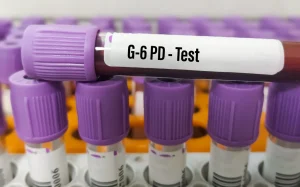G6PD DEFICIENCY
G6PD DEFICIENCY

G6PD (Glucose-6-Phosphate Dehydrogenase) deficiency is a hereditary disease characterised by a lack of the G6PD enzyme, essential for proper red blood cell function. This deficiency can lead to the destruction of red blood cells, known as haemolysis.
Symptoms include pale skin, jaundice, dark urine, fatigue, difficulty breathing, and an enlarged spleen. It is primarily inherited through the X chromosome, affecting males predominantly.
Medications, infections, and oxidative stressors can trigger haemolysis in individuals with G6PD deficiency. Medical treatment focuses on symptom management and avoiding triggers. Blood tests determine G6PD enzyme levels, and certain medications are to be avoided. Blood transfusions may be necessary in emergencies to stabilise haemoglobin levels.
A diet rich in iron is recommended, including lean meats, fish, eggs, and legumes, supporting red blood cell production. Folic acid-rich foods like green leafy vegetables, beans, lentils, and citrus fruits aid in red blood cell formation.
A balanced diet with fruits, vegetables, whole grains, lean proteins, and healthy fats is advised. Avoiding oxidative stressors such as certain medications and fava beans is crucial.
Consultation with healthcare professionals or registered dieticians ensures personalised dietary guidance for G6PD deficiency management.
Description
G6PD (Glucose-6-Phosphate Dehydrogenase) deficiency is a genetic disorder that affects the functioning of red blood cells. It is caused by a deficiency of the G6PD enzyme, which plays a crucial role in protecting red blood cells from oxidative damage. This condition primarily affects males, although it can also occur in females.
When individuals with G6PD deficiency are exposed to certain triggers like certain foods, infections, or medications, their red blood cells become more susceptible to breaking down, leading to a condition known as haemolytic anaemia.
Symptoms of G6PD deficiency can include fatigue, pale skin, dark urine, jaundice, and in severe cases, even life-threatening complications.
Management of G6PD deficiency involves avoiding triggers and adopting a careful approach to medications and diet. Genetic counselling may be recommended for individuals and families affected by this condition.
Not all individuals with G6PD deficiency experience these symptoms, and the severity and frequency of symptoms can vary widely among affected individuals. Symptoms of G6PD Deficiency:
- Pale Skin: People with G6PD deficiency may experience paleness of the skin, known as pallor. This can be a result of the breakdown of red blood cells (haemolysis) and a decreased supply of oxygen to the body tissues.
- Yellowing of the Skin (Jaundice): Jaundice is a common symptom of G6PD deficiency. It occurs due to the build-up of bilirubin, a yellow pigment, in the bloodstream when red blood cells are destroyed at a faster rate. Jaundice can cause the skin, whites of the eyes, and mucous membranes to turn yellow.
- Dark Urine: Haemolysis of red blood cells can lead to the release of haemoglobin, a protein that gives urine a dark or tea-coloured appearance. Dark urine is a common symptom in individuals with G6PD deficiency during haemolytic episodes.
- Exhaustion: Fatigue and exhaustion may occur due to the decreased oxygen-carrying capacity of the blood as a result of haemolysis. This can lead to reduced energy levels and a feeling of weakness.
- Difficulty Breathing: In severe cases of haemolysis, individuals with G6PD deficiency may experience difficulty breathing, especially when the body is under stress or during haemolytic crisis.
- Spleen Enlargement: Prolonged haemolysis can lead to an enlarged spleen (splenomegaly). The spleen plays a role in removing damaged red blood cells from circulation, and in G6PD deficiency, it may become overactive.
- Fast Heartbeat: An increased heart rate (tachycardia) may occur during haemolytic episodes, as the body attempts to compensate for the reduced oxygen-carrying capacity of the blood.
Different types of G6PD include:
- G6PD A-: This is the most common type of G6PD deficiency and is prevalent in many parts of the world. It is usually less severe, and affected individuals may experience mild to moderate symptoms if exposed to triggers like certain medications or infections.
- G6PD Mediterranean: This type of G6PD deficiency is more common in populations from the Mediterranean region. It can lead to a moderate to severe deficiency of G6PD enzyme activity, resulting in a higher risk of symptoms and complications.
- G6PD Canton: G6PD Canton is found in certain Asian populations and can cause a more severe deficiency of the G6PD enzyme. It is associated with a higher risk of symptoms and complications when exposed to certain triggers.
- G6PD Seattle: This type of G6PD deficiency is more commonly found in individuals of African descent. It can lead to varying degrees of enzyme deficiency and may result in symptoms in response to certain triggers.
- G6PD Union: G6PD Union is a rare type of G6PD deficiency and has been reported in specific populations.
Causes of G6PD deficiency are:
- Genetic Mutation: G6PD deficiency is primarily a genetic condition, meaning it is inherited from one's parents. It is caused by mutations in the G6PD gene, which is located on the X chromosome. Since it is an X-linked recessive disorder, it primarily affects males, although females who inherit two copies of the mutated gene can also be affected.
- Exposure to Triggers (Oxidative Stressors): While individuals with G6PD deficiency may not experience symptoms under normal conditions, certain factors or triggers can lead to haemolytic episodes (the destruction of red blood cells). These triggers create oxidative stress on the red blood cells and can include:
Certain Medications: Some medications, such as antimalarial drugs (e.g., primaquine, chloroquine), sulfonamides, and certain antibiotics, can induce haemolysis in individuals with G6PD deficiency. It's important for affected individuals to avoid these medications or take them under medical supervision.
Fava Beans: Consumption of fava beans (broad beans) can trigger haemolysis in some individuals with G6PD deficiency. Avoiding these beans is typically recommended.
Infections: Infections, particularly those causing a fever, can lead to oxidative stress on red blood cells and trigger haemolysis in individuals with G6PD deficiency.
Exposure to Chemicals: Exposure to certain chemicals, such as naphthalene (found in mothballs), can also lead to haemolysis in susceptible individuals.
Here are some key aspects of medical treatment for G6PD deficiency:
- Avoiding Triggers: The primary approach to managing G6PD deficiency is to avoid triggers that can cause a hemolytic crisis (destruction of red blood cells). Common triggers include certain medications (e.g., antimalarial drugs, sulfonamides), specific foods (e.g., fava beans), and infections (e.g., viral or bacterial infections).
- Medication Management: If a person with G6PD deficiency develops an illness that requires medication, it's essential to consult with a healthcare provider who is knowledgeable about the condition. They can recommend alternative medications that are safe for individuals with G6PD deficiency.
- Folic Acid Supplementation: Some healthcare providers may recommend folic acid supplementation to support the production of red blood cells and prevent anaemia in individuals with G6PD deficiency.
- Managing Complications: In severe cases of G6PD deficiency, individuals may experience complications such as hemolytic anaemia. Treatment for these complications may involve blood transfusions, but this is typically reserved for severe cases and is not a routine treatment.
- Lifestyle Modifications: Individuals with G6PD deficiency can lead healthy lives by making dietary and lifestyle adjustments to avoid triggers. This includes maintaining a balanced diet, staying hydrated, and being cautious about medications and substances that can cause haemolysis.
- Education and Monitoring: Education about the condition is essential for individuals with G6PD deficiency and their caregivers. Regular monitoring by a healthcare provider can help ensure that any potential complications or symptoms are detected and managed promptly.
Management strategies may vary based on the severity of the deficiency and an individual's specific triggers and needs.
- Dietary Considerations: Eating dried fruits like figs and dates can be part of a well-balanced diet, but it's essential for individuals with G6PD deficiency to be cautious about certain foods and ingredients that can trigger haemolysis. Avoiding fava beans is crucial, as they are a known trigger for haemolysis in people with G6PD deficiency. Additionally, individuals should be mindful of other dietary sources of potential triggers, such as certain legumes, food colourings, and some herbal supplements.
- Hydration: Staying well-hydrated is important for overall health and can help prevent complications, but it's essential to consume a balanced and varied diet to ensure adequate nutrients.
- Avoiding Oxidative Stressors: While avoiding oxidative stressors is crucial, it's essential to clarify that this primarily involves steering clear of specific medications, chemicals, and substances known to induce haemolysis. These can include certain antibiotics, antimalarial drugs, and chemicals like naphthalene (found in mothballs). Individuals should work closely with their healthcare providers to identify and avoid these triggers.
- Rest: Adequate rest is essential for overall well-being and can help individuals with G6PD deficiency manage their condition, especially during or after a haemolytic episode.







